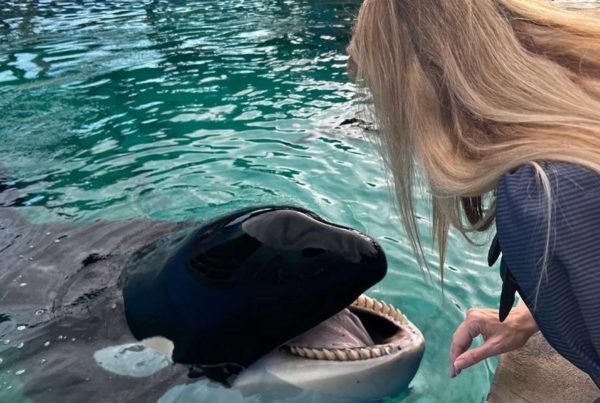Over the years, Miami Seaquarium has suffered damage and animal deaths from hurricanes; however, against all odds, Lolita has survived.
During Hurricane Irma, animals were abandoned and left in their tanks; this included Lolita. Wild dolphins dive deep into the ocean to ride out a storm safely. Lolita could not do that in her shallow and tiny tank.

If Miami Seaquarium cannot safely evacuate the animals from their facility, which has tanks at sea level and sits on the polluted Biscayne Bay, they should not have them.
One day a category 5 hurricane could directly hit the Seaquarium, and they will do the same as they have always done; abandon their animals. This time, it would result in countless and devastating deaths.
If a handful of ‘caretakers’ stay on-site during hurricanes, dealing with the devastating damage would be beyond anyone’s capabilities. Doing the bare minimum, such as taking down umbrellas, securing objects that could become loose in the howling wind and driving rain, and placing flamingos in a restroom, is not enough.
With the increase in weather extremes, climate change, rising water levels and Miami Seaquarium’s location, maybe, the outdated, run-down 1950s roadside zoo should not exist at all.
Lolita is vulnerable to potentially fatal injuries
- Flying debris
- Blunt force trauma
- Extreme stress and PTSD
- Stadium roof collapse
- The glass in her tank could shatter
- Power failure of filtration and refrigeration systems
- Exposure to highly contaminated floodwater
- Lightening strikes
- Storm surge could damage construction jacks placed under the tank to support it
Hurricane damage at Miami Seaquarium
Irma (2017):
Seven Nile crocodiles died, and two bottlenose dolphins, 31-year-old Noel and his 14-year-old daughter, Rioux, perished in the aftermath of the hurricane.
The filtration system is also faulty, as shown by drone footage directly after Irma. Lolita’s tank was murky, and it seemed like she was swimming in a cesspool.
Excerpt Miami New Times:
Drone footage captured by Dolphin Project’s Lincoln O’Barry, after the storm showed Lolita alive, swimming in murky water. Ventre fears that water pumps might not have been filtering the water in her pool: “It looks like she’s swimming in a cesspool,”
Video footage from O’Barry shows the Seaquarium sustained damage and flooding. “If [the Seaquarium] has no plan or protocol during a storm other than leaving her behind, then Lolita shouldn’t live there,” O’Barry says. “It’s a death sentence.”
Wilma (2005):
Storm surge from Hurricane Wilma dropped silt into low-lying exhibits, killing more than 1,000 fish and 15 sharks. The storm also downed trees, flooded large parts of the park and damaged its seawall.
Curators collected more than 2,500 fish from Biscayne Bay and nearby reefs to replace the fish that died after the storm.
“There’s twice as many fish as there were before Wilma,” Seaquarium curator Robert Rose said.
Some new fish were donated, while Rose and other staff members went out on boats and donned scuba gear to do some of the collection themselves.
Andrew (1992):
Five sea lions were electrocuted, and several sharks died because the pumping system caused their pool to flood.
Ref:
i) “Lolita, Miami Seaquarium’s Orca, Left in Tank During Hurricane Irma.” https://bit.ly/3UNfOqp
ii) “Two Dolphins Died at Miami Seaquarium After Hurricane Irma.” https://bit.ly/3BXawjr
iii) The Loneliest Orca in the World: Lolita – Melanie Sztybel
iv) Puget Sound Orca in Captivity: The Fight To Bring Lolita Home – Sandra Pollard



